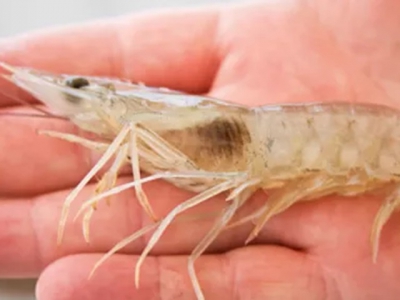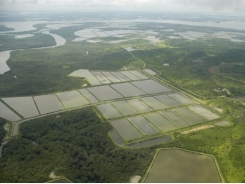Rainy season effects on shrimp grow-out ponds (Part 2)

Acidity (pH)
Rainfall has a pH of 6.5 to 6.7 in coastal Ecuador and shrimp ponds usually have values between 7.5 and 8.5, and a drop of 0.3 to 1.5 can occur during rains. Abrupt die-offs of phytoplankton populations in ponds very often result, although it is important to note that salinity decreases do not entail the same problem and, in fact, the cyanobacteria (blue-greens) dominate under low salinity conditions.
These massive phytoplankton mortalities provide a huge amount of simple sugars to the pond ecosystem as autolysis breaks down cell walls and release the cytoplasm into the water. Within a few hours there typically is an exponential increase of heterotrophic bacteria that begin to assimilate the sugars. But there is a metabolic cost in the consumption of most/all dissolved oxygen available for respiration, before switching to the alternative anaerobic route that is much less efficient. Aerobic respiration also produces carbon dioxide, which after hydrolysis forms carbonic acid, which then depresses the pH even more. So, in a short time the pH disruption caused by the rains can result in a serious situation where the pH will continue to drop until it can the phytoplankton populations are restored.
Dissolved oxygen
Dissolved oxygen (DO) levels are the most critical factor in shrimp production. Its saturation level in water is 25 times lower than for ambient air for the same temperature. Therefore, dissolved oxygen will always be the first limiting factor in the aerobic production of aquatic biomass.
Although decreases in pond water temperature and salinity due to rains increase the maximum capacity (saturation point) of oxygen absorption by pond water, the lack of photosynthesis will be the determining factor regarding the DO levels in the pond. This, combined with the increase in biological oxygen demand (BOD) by heterotrophic bacteria and in the absence of additional (mechanical) aeration, can lower the DO to dangerous levels (equal or less than 3 ppm) in less than half an hour. And low DO levels can increase the reduction of sulfates to sulfites, eventually leading to the production of toxic H2S.
Salinity and hardness
Both salinity and hardness are functions of dissolved ion concentrations, so if there is an increase in the pond water volume, the concentrations of all ions will decrease.
It is unusual for shrimp mortality to be directly related to salinity during grow-out; however, there will be significant effects at the level of the animals’ homeostasis (internal auto-regulation to be in a stable state). The shrimp post-molting phase involves the active absorption of calcium and magnesium ions from their medium to harden their exoskeletons (shells), and this process cannot proceed in the absence of these ions. Consequently, there will be a significant increase in cannibalism and mortality related to secondary infections caused by opportunistic pathogens. These chronic shrimp mortalities are typically not noticed until weeks after the rainfall event, which complicates the situation even more.
Wind and wave action
The wind acting on the surface of a body of water creates waves due to the transfer of kinetic energy from the air to the water. The amplitude and wavelength of the waves (the factors that determine the magnitude of energy transferred) depend on the force of the wind, the duration that blows and the “fetch” or distance on which the wind acts on the surface of the water. Consequently, larger ponds exposed to strong winds for extended periods will have the largest waves.
When they break, waves transfer their energy to the pond levies. The resulting erosion of the most exposed levee slopes increases pond water turbidity and reduces sunlight penetration, which contributes significantly to potential phytoplankton die-offs and all the problems associated with the absence of a healthy microalgae population in the pond.
Another effect is subtler but equally or even more problematic. All earthen ponds have an aerobic microlayer on their muddy bottoms, which normally acts as a barrier between the anoxic subsoil and the relatively oxygen-rich water. This barrier determines the interface between the reductive reactions of the subsoil and the oxidative reactions of the water column. This thin layer of aerobic substrate has limited mechanical strength and is very easy to dislodge by the turbulence associated with wave action. When this happens, the resulting products of the reductive chains – H2S and nitrite – normally trapped in the subsoil can have free access to the water column and can potentially have toxic effects on the shrimp.
Recommended practices to minimize the impact of heavy rains
Before the rains:
Clean and enlarge the drainage channels. In some cases, it may be necessary to install a pump station at one end of the drainage channel to mechanically discharge rainwater when the level of the river exceeds the level of drainage.
Place bags of calcium carbonate (500 kg/ha) on the walls. When it rains, the calcium carbonate dissolves and penetrates through the walls, helping maintain the pH and hardness within acceptable pond values. In extreme cases, potassium chloride applications at 100 kg/ha is recommended.
Repair and compact the slopes of the levies and dykes, and protect the areas of greatest erosion with sand-filled feed bags and with barriers of chopped cane stalks.
Ensure that all pond drainage gates allow for surface drainage. PVC pipes horizontally buried in the levies at the height of the full pond can increase the efficiency of this type of drainage.
If the shrimp farm has them, test all aeration equipment and the electrical network installation and control panels. If there is no mechanical aeration installed, I recommend that at least one mobile aerator be secured that can be moved between ponds using a small tractor.
During the rains:
Drain surface water.
Measure DO and pH continuously, and if the pH drops, apply calcium carbonate.
Reduce feeding by 70 percent of the normal ration, and keep reducing it according to the temperature and DO data.
Turn on all available mechanical aerators and try to maintain DO levels above 4ppm at all times.
Monitor the health of the pond microalgae by observing samples using a microscope – dead cells can still be green. Healthy algae cells have a full central vacuole and there is no separation between the cell wall and the membrane. If an algae die-off is about to happen, sometimes it can be prevented by pond water exchange to reduce the algae cell density and by raising the pH.
After the rains:
Apply progressively increasing amounts of aquafeed in the pond as the temperature rises, as long as the pH and DO values are acceptable and the shrimp population is known. It is very important to reconfirm the shrimp population estimate after the rain event. Because shrimp mortality tends to be chronic, daily population sampling should be carried out for at least a week afterwards.
Add vitamin C, and potassium, sodium and magnesium salts to the aquafeed before feeding.
Some authors recommend the addition of probiotics (presumably species with a high capacity for decomposing organic matter) in high dosages to prevent the domination of unwanted bacteria. Because of the absence of independent scientific work on this subject, I cannot recommend or not recommend this practice.
Maintain high levels of aeration until there is a new, stable population of microalgae in the pond.
Conclusions
The overall effect of excess rainfall in a shrimp pond is shrimp mortality to a greater or lesser degree. This population reduction can have several causes, such as anoxia, secondary infections, cannibalism, H2S toxicity and other problems associated with incomplete molting. This mortality commonly occurs two to three days after the rains, without obvious signs such as the presence of seagulls, for example.
Therefore, it is very important that shrimp farm managers understand the processes associated with heavy rains and are prepared to take appropriate actions to limit the economic risk that characterizes seasonal rainfall.
References available from author.
Related news
Tools

Phối trộn thức ăn chăn nuôi

Pha dung dịch thủy canh

Định mức cho tôm ăn

Phối trộn phân bón NPK

Xác định tỷ lệ tôm sống

Chuyển đổi đơn vị phân bón

Xác định công suất sục khí

Chuyển đổi đơn vị tôm

Tính diện tích nhà kính

Tính thể tích ao




 Clinical case report: EMS/AHPND outbreak in Latin America
Clinical case report: EMS/AHPND outbreak in Latin America  Effective management avoids gas bubble trauma
Effective management avoids gas bubble trauma